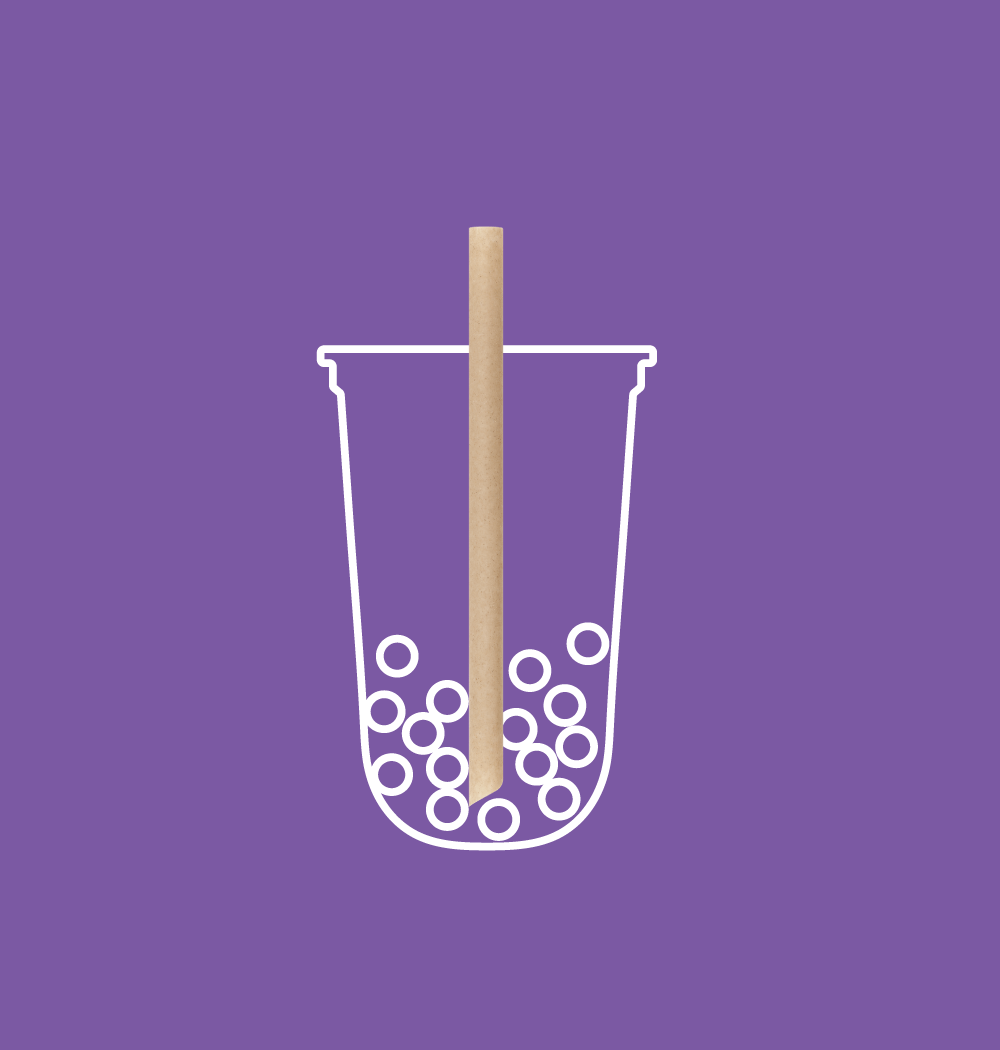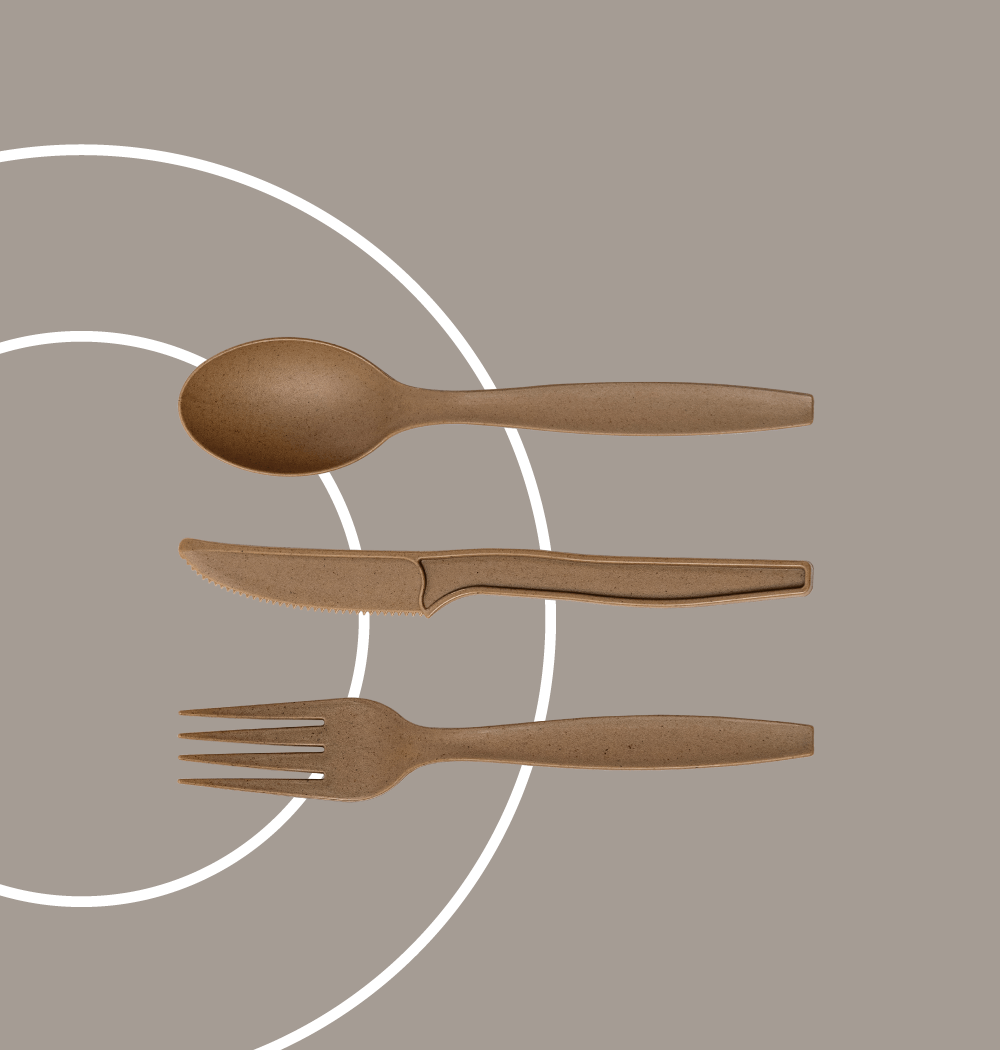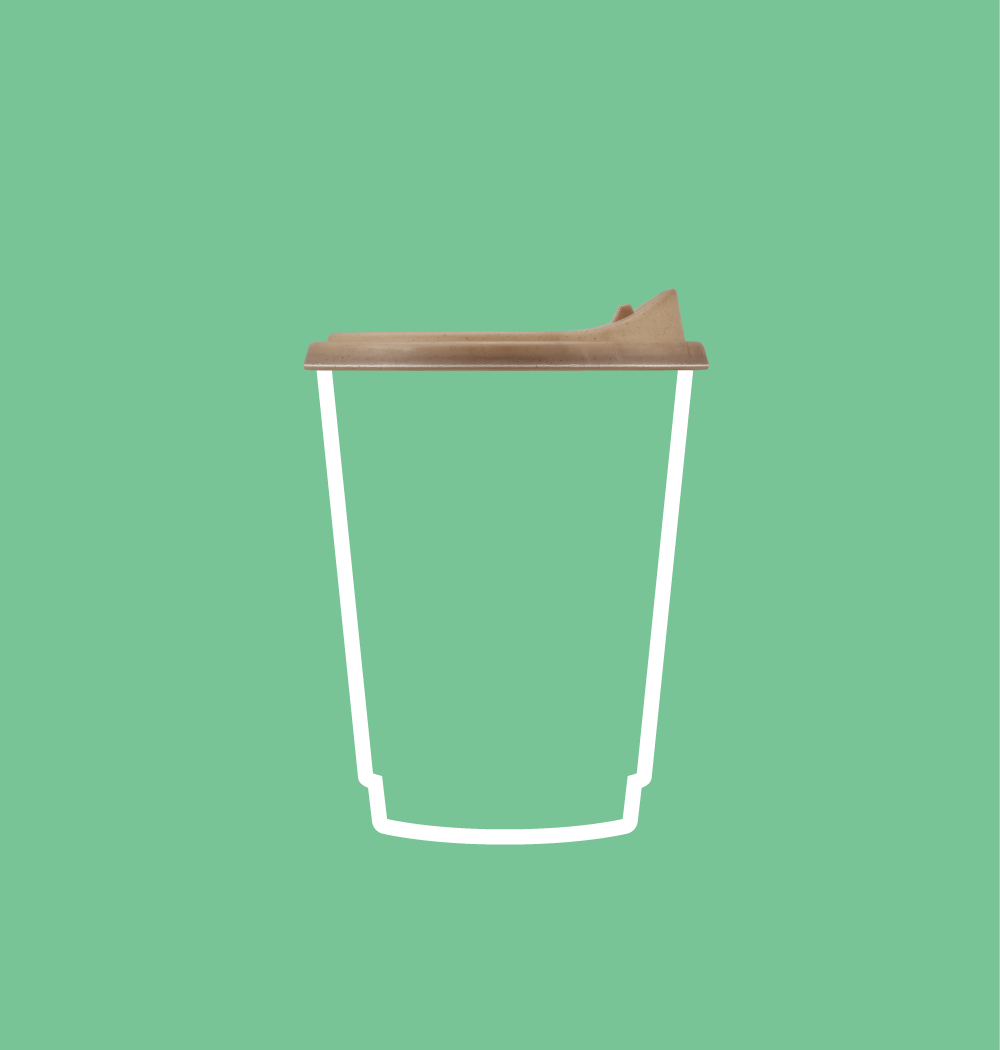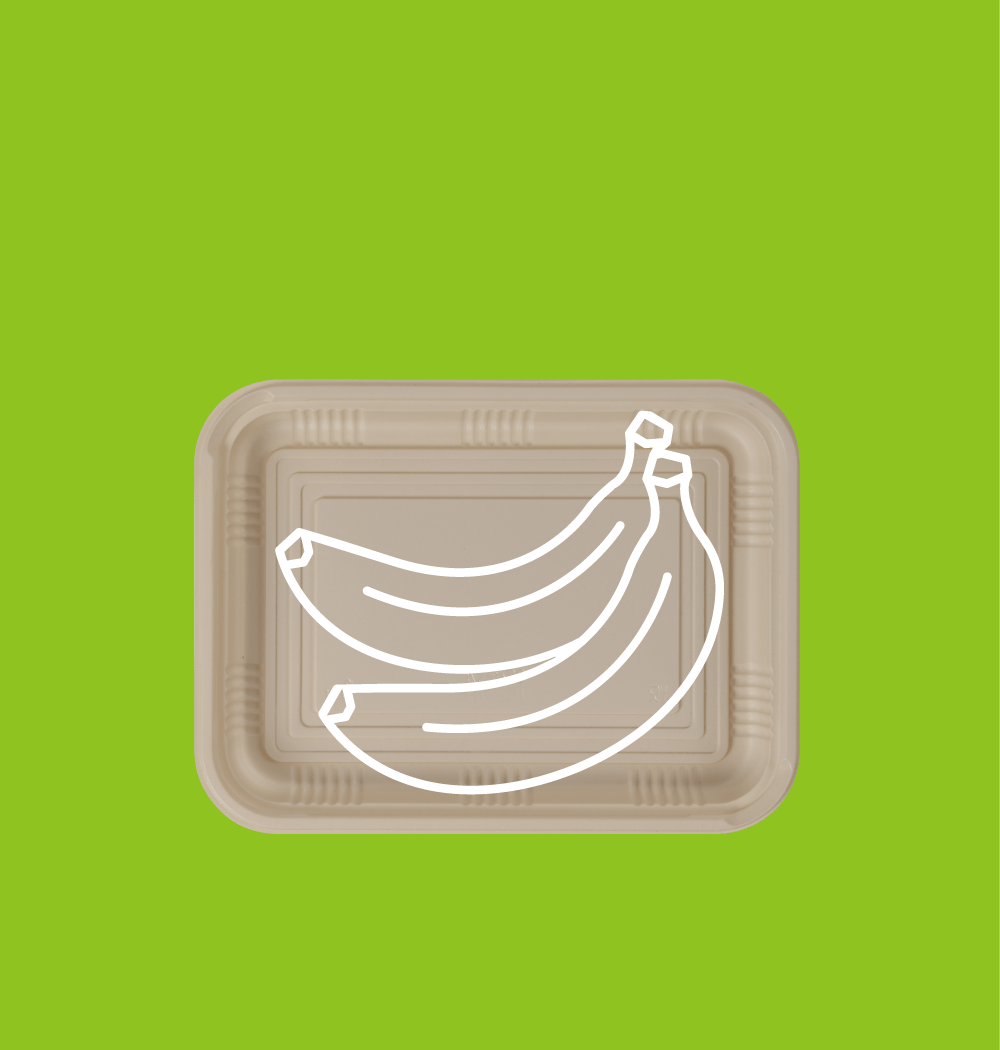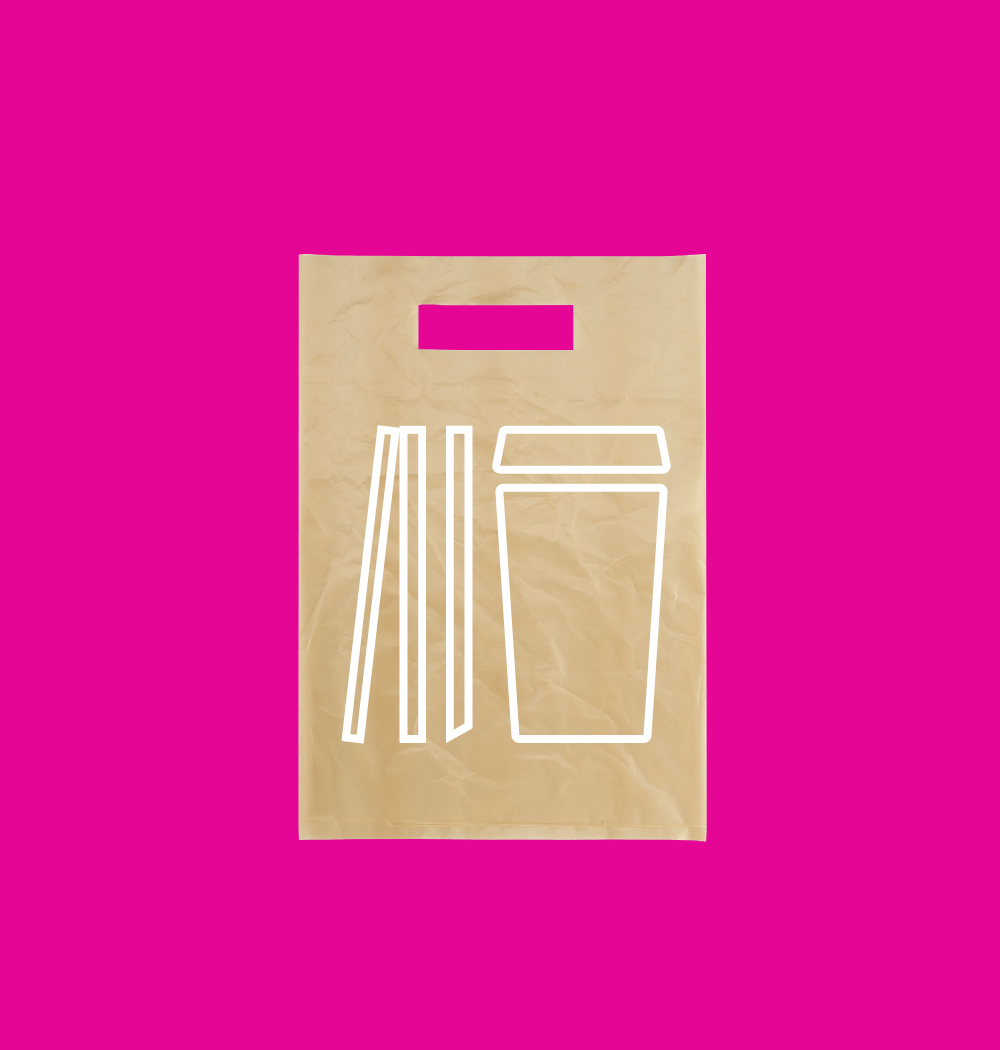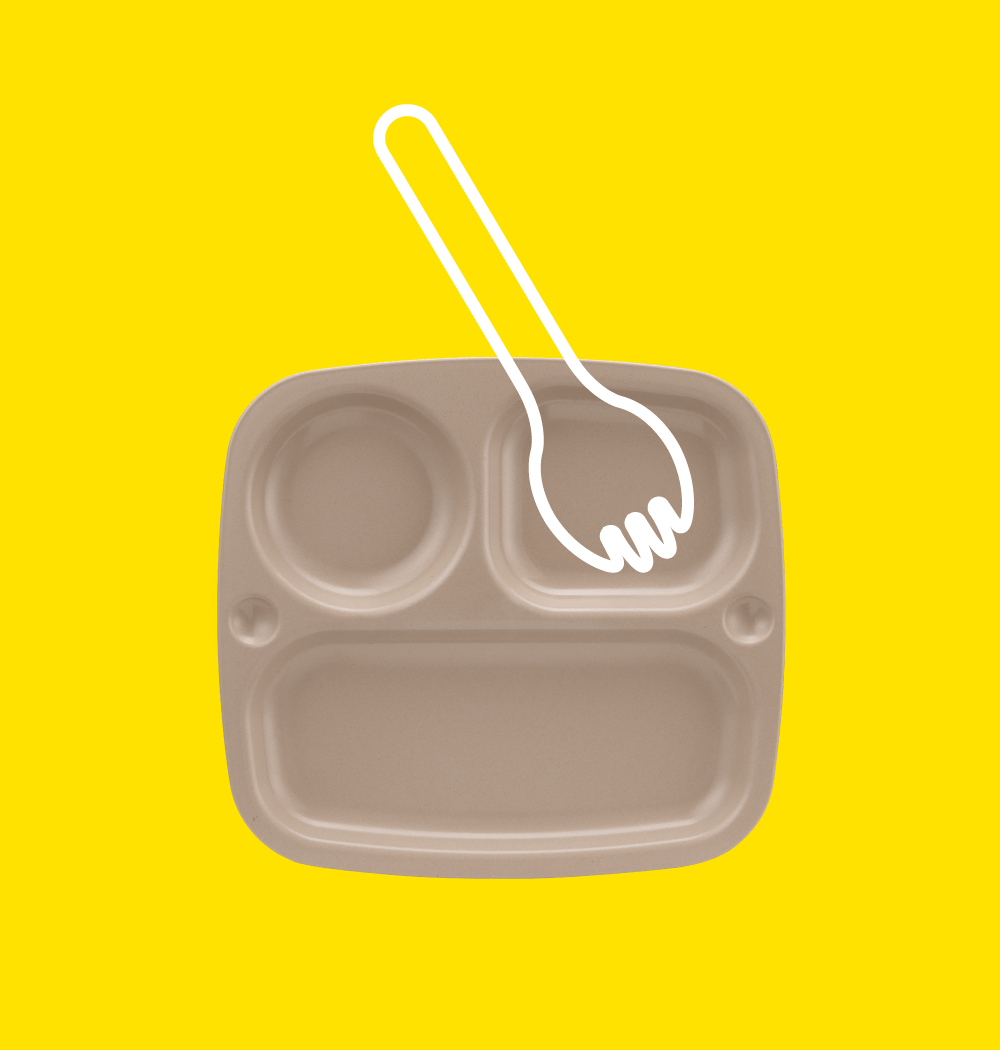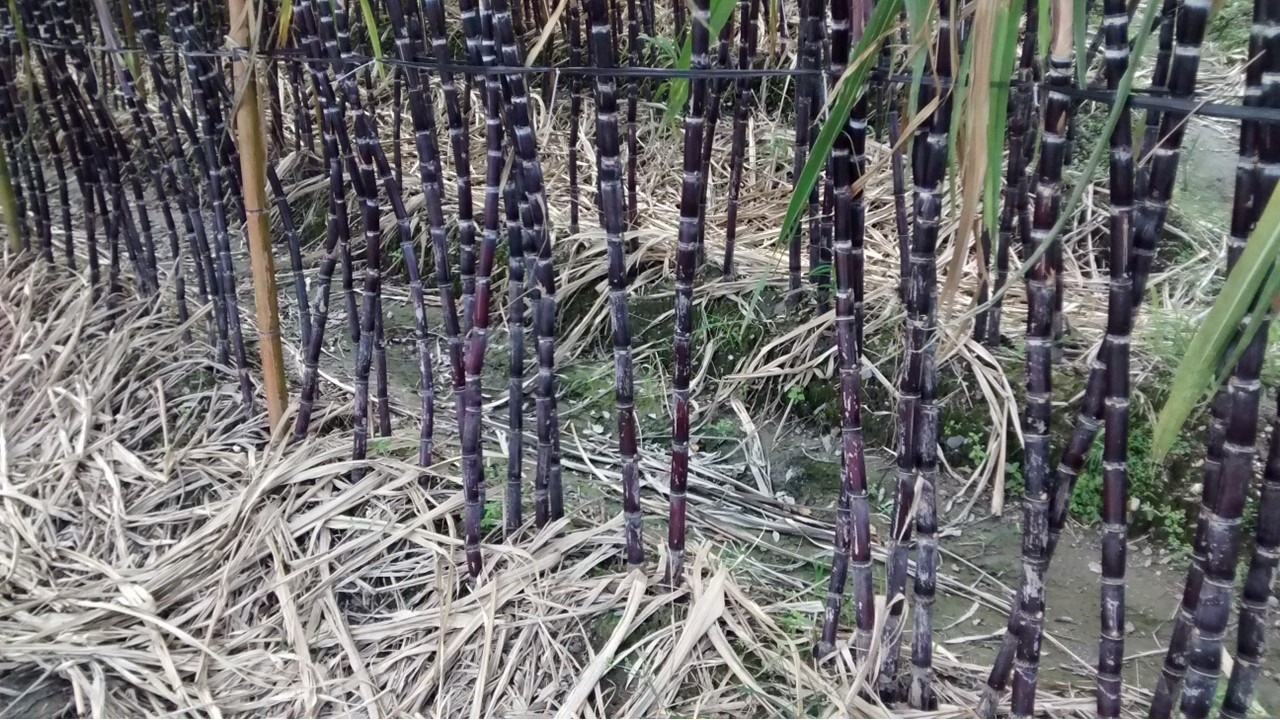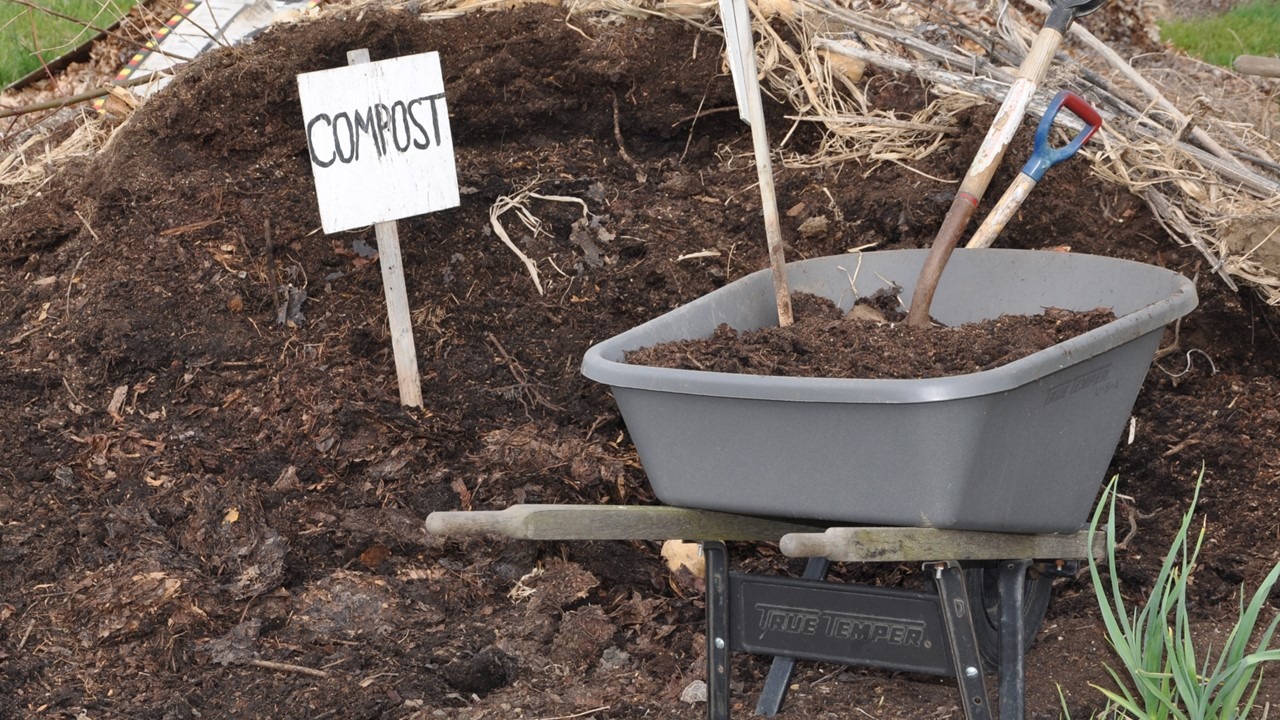Due to their light weight, high strength, and low cost, plastics are used excessively by people. However, not all plastics can be recycled, nor can they be broken down naturally. Whether they end up in incinerators, landfills, or the environment to pollute lakes, rivers, and oceans, plastics can cause severe damage to the planet. Consequently, “plastic-free” has become the foremost goal of people. This article will elaborate on the concept of plastic-free, and, more specifically, how we can implement plastic-free plans.
Why go plastic-free?
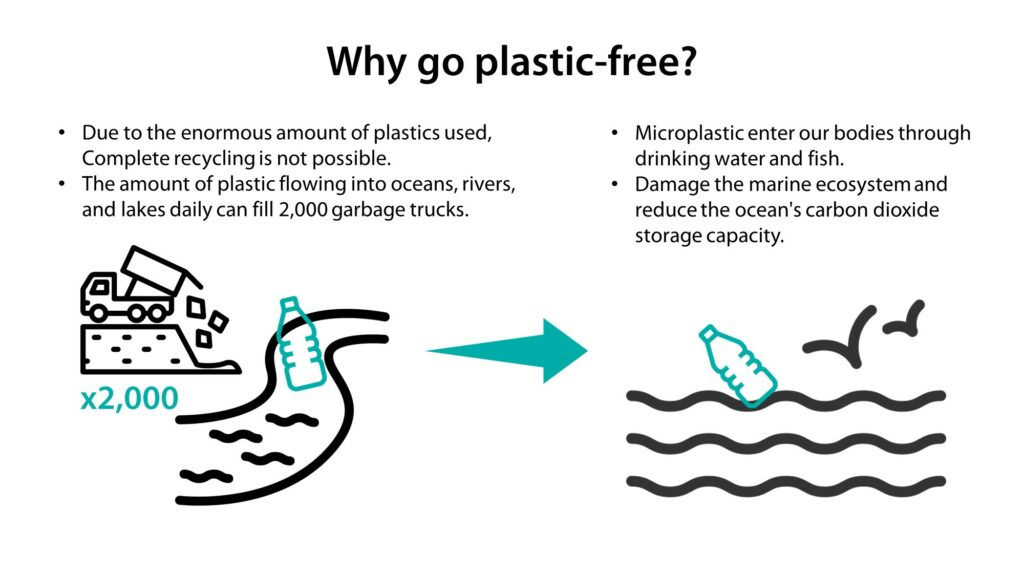
According to United Nations statistics, the amount of plastic flowing into oceans, rivers, and lakes daily can fill 2,000 garbage trucks, while 19-23 million tons of plastic waste enter the aquatic ecosystem every year. Plastics that enter the aquatic ecosystem will float on the water surface, leading to the reduction of dissolved oxygen and light, as well as the extinction of aquatic animals and plants. To make matters worse, the plastics will gradually decompose in the environment and release microplastics. After absorbing heavy metals and other harmful substances, the microplastics will enter our bodies and affect our health when we drink water or eat marine life.
Besides their impact on the aquatic system, plastics are also a major cause of climate change because a lot of energy is required to refine and form plastics during their production process. In addition, the ocean is an important CO2 storage site, called the “blue carbon sink”, which is as important as forests; plastics can wreak havoc on marine ecosystems and affect their carbon sequestration ability.
Some people may think that recycling will suffice and that being plastic-free is not necessary. However, according to the statistics of the United Nations and the Organisation for Economic Co-operation and Development (OECD), the global recycling rate of plastics in both 2018 and 2019 was below 10%, because many plastics such as paper box plastic coating, straws, bags, and cigarette butts are difficult to recycle, while plastic bottles are more easily recycled. However, due to the enormous amount of plastics used, even if only a small portion flows into the environment, it is still a very respectable amount. Consequently, being plastic-free is the only solution that can get to the bottom of the problem.
What does going plastic-free mean?
Plastics were originally an eco-friendly material developed to replace paper, ivory, and tortoise shells. The production technology reached maturity in the 1950s. Because of its lightness, malleability, and low cost, plastics have been widely used by people in various industries. However, people soon realized that plastics will accumulate in the ocean. In 2011, Rebecca Prince-Ruiz kicked off the Plastic Free July campaign to encourage people to reduce the use of plastics or refrain from using them at all every July to make a difference in our lives in the future. Now, plastic reduction has become a global consensus. “Zero plastic” can also be used to describe a material that has been tested to contain zero plastic materials such as polyethylene (PE), polypropylene (PP), polyvinyl chloride (PVC), polystyrene (PS), or polyethylene terephthalate (PET).
How do you go plastic-free? Step by step now
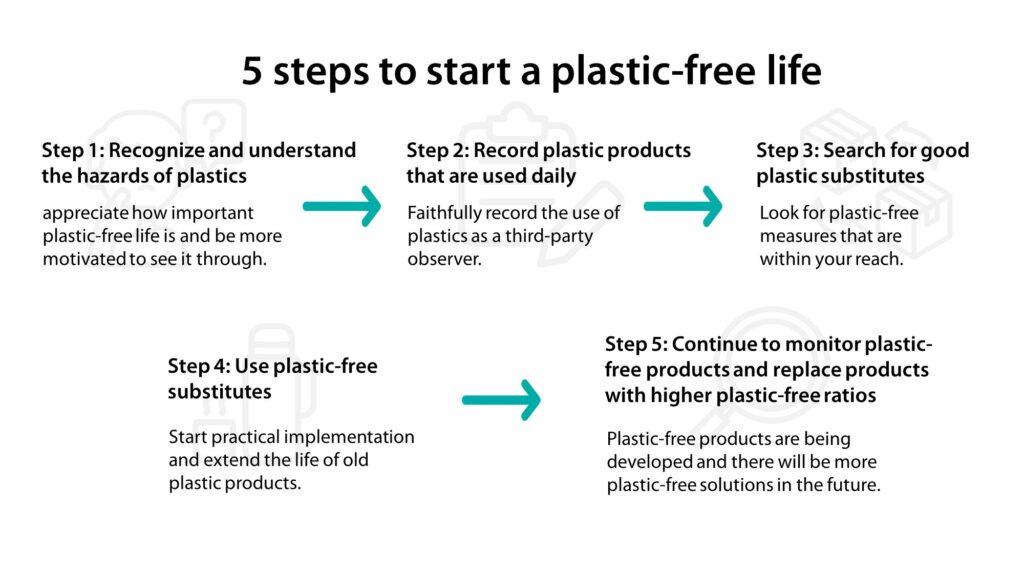
Step 1: Recognize and understand the hazards of plastics
Before starting a plastic-free life, it is imperative to recognize and understand the hazards of plastics. We must be aware that everything made of plastic in our lives will cause untold damage to the environment because the haphazard use of a straw may lead to accidental ingestion by a sea turtle, causing its demise. Only after understanding the hazards associated with plastics can we appreciate how important plastic-free life is and be more motivated to see it through.
Step 2: Record plastic products that are used daily
The first step to starting a plastic-free life is to record plastic products that are currently being used. Spend a week documenting all the plastic products you have used and discarded, bearing in mind to ignore the vision of a plastic-free life momentarily during the process and truthfully recording the use of plastics as a third-party observer.
Step 3: Search for good plastic substitutes
After understanding the daily use of plastics, you can determine the products with the highest frequency and quantity and give priority to seeking their substitutes. For instance, if you discovered that you buy a cup of coffee every day before going to work, and the paper cup consists of a plastic coating and a plastic lid, bringing a thermos cup to the store to hold the coffee can make it a part of your plastic-free life.
Step 4: Use plastic-free substitutes
Besides reducing the use of disposable plastics, there are also plastic-free alternatives for some reusable plastic consumables. For example, synthetic plastic gloves used for cleaning can be replaced with natural latex gloves when they become unusable instead of discarding them and replacing them right away.
Step 5: Continue to monitor plastic-free products and replace products with higher plastic-free ratios
People rely heavily on plastics due to technical or cost issues, hence plastic-free living cannot be achieved overnight. Fortunately, more and more manufacturers are committed to the development of plastic-free products to gradually resolve this problem. People can regularly search for frequently used plastic products that have yet to be replaced and see if new solutions are available to increase the plastic-free ratio.
30 ideas and ways to go plastic-free
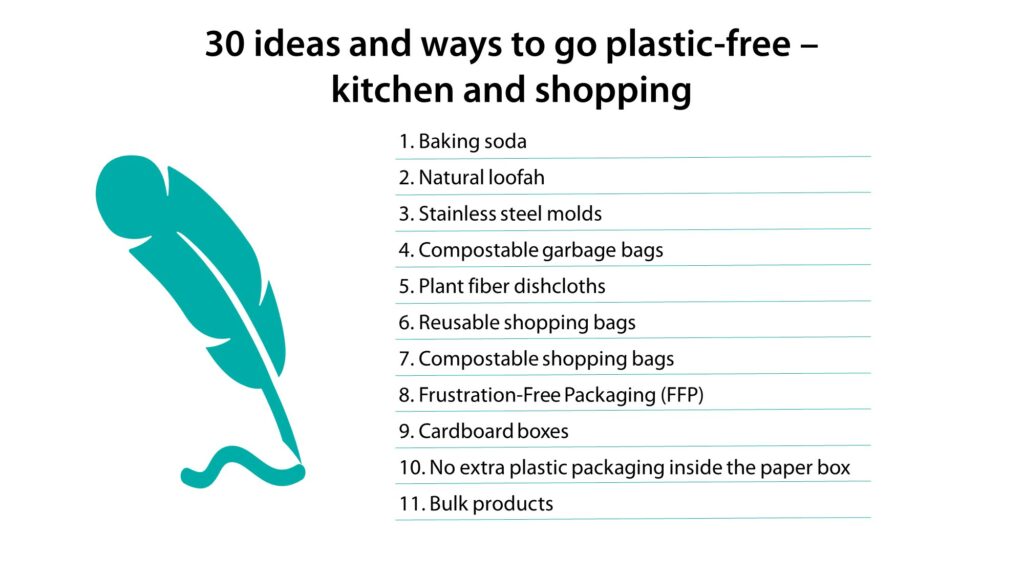
Zero plastic solutions in the kitchen:
- Use baking soda instead of dishwashing liquid because it is natural, healthy, and reduces the plastic bottles and plastic refill packs of dishwashing liquid.
- Use a natural loofah to scrub bowls and plates because it can absorb fat and offers comparable cleaning performance to synthetic sponges.
- Plastic molds in the refrigerator develop cracks and accumulate grime over time after repeated thermal expansion and contraction; replace them with stainless steel molds to ensure safety and durability.
- Remember to separate plastic bags when disposing of kitchen waste. Compostable garbage bags can be placed in organic waste recycle bins with kitchen waste and sent to a composting facility for decomposition.
- Non-woven dishcloths are consumables that gradually become dirty and worn out over time. They can be replaced with plant fiber dishcloths, which can be returned to the environment via composting after becoming unusable.
Zero plastic shopping tips:
- Plastic bags are the most common form of marine waste; carrying reusable shopping bags to replace disposable plastic bags is an excellent zero-plastic shopping method.
- If disposable plastic bags are needed, choose shops that provide compostable shopping bags to reduce the use of plastics.
- If Amazon is the preferred online shopping platform, choose products with Frustration-Free Packaging (FFP) to ensure that packaging is 100% recyclable, easy to open, and only a minimal amount of packaging material is used.
- When shopping online on other platforms or with individual sellers, ask the seller to use cardboard boxes as packaging instead of non-recyclable poly bags.
- When purchasing cereals or biscuits, consider whether there is concealed plastic packaging inside the paper box.
- Buy bulk products and package them separately by yourself. Bring your containers to save up to 96% on packaging. Common products that you can buy in bulk include peas, sweets, grains, biscuits, pet food, tea, cooking oil, and laundry detergent.
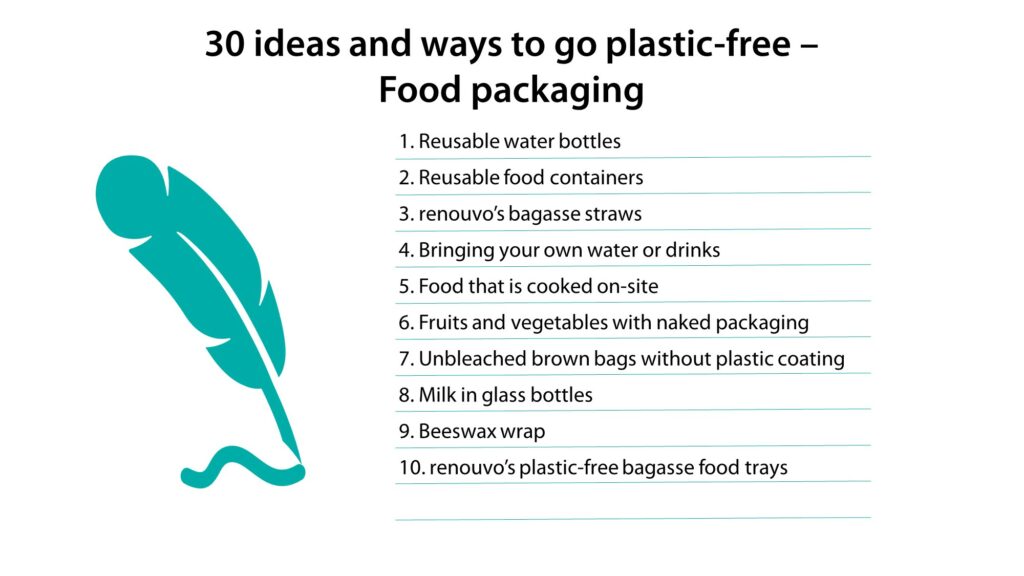
Ideas for zero plastic food packaging:
- Carry reusable water bottles with you to hold drinking water or beverages. Avoid using paper cups with plastic coating and lids.
- When buying food, bring reusable food containers such as storage containers to avoid using plastic lunch boxes or paper lunch boxes with plastic coating.
- Use plastic-free bagasse straws instead of plastic straws, which can be composted after use. Iconic manufacturers include renouvo.
- Keep a habit of drinking water or bringing your own drinks to reduce the chance of buying beverages in plastic bottles.
- Although frozen food is very convenient, it usually comes with plastic packaging, so you should choose food that is cooked on-site first.
- Since we wash fruits and vegetables before consumption, choose fruits and vegetables with naked packaging to prevent unnecessary plastic bags.
- When choosing what bread to buy, use unbleached brown bags without plastic coating and plastic windows as containers because they can be composted and returned to the environment after use.
- Milk cartons have a plastic coating to achieve water resistance and keep the content fresh. Choose milk in glass bottles to reduce the use of plastics.
- If you want to keep leftover food as your next meal, use beeswax wrap instead of plastic wrap.
- Use renouvo’s plastic-free bagasse food trays to distribute food to your party guests, which helps to reduce the use of plastic food trays.
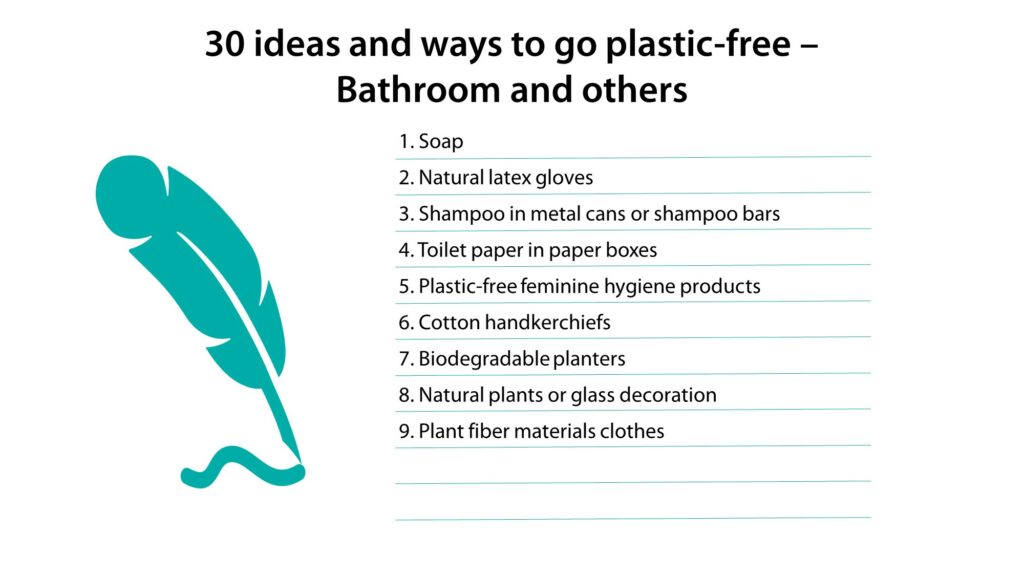
Plastic-free bathroom
- Use soap instead of laundry detergent to reduce plastic bottles and chemical agents.
- Use natural latex gloves in place of plastic gloves because they offer better elasticity and durability. However, pay attention to latex allergy.
- Use shampoo in metal cans or shampoo bars instead of shampoo in plastic bottles to reduce waste plastic bottles.
- Choose toilet paper in paper boxes instead of plastic packaging.
- Use plastic-free feminine hygiene products as they are natural, safe, and healthy.
- Wet wipes contain plastic adhesives and chemical moisturizers, and most of them have plastic packaging. Thus, use cotton handkerchiefs instead to reduce the use of plastics.
Other plastic-free ideas in life
- Biodegradable planters are made of plant fibers such as coconut shells, grain husks, or hay, making them suitable for plants that will be transplanted in the future as they can be buried directly in the soil with potted plants.
- Use natural plants or glass instead of plastic decor to make spaces more elegant.
- Clothes are consumables, and polyester fibers and nylon are common plastics used in the textile industry. Select cotton or linen and other plant fiber materials to ensure that the clothes will not contaminate the environment after they are worn out and discarded.
Four tips to make sure your plan to go plastic-free succeeds
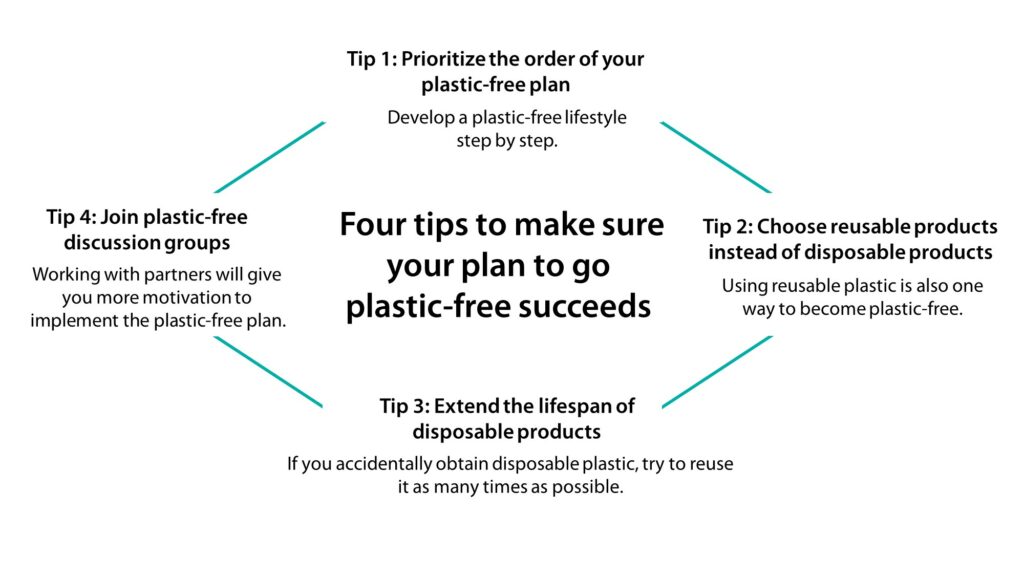
Tip 1: Prioritize the order of your plastic-free plan
Going plastic-free is a long-term endeavor, and plastic cannot be completely removed from our lives even if no expenses are spared. This is because old habits die hard, while perfectionism and a sense of guilt will hinder the plastic-free project. Once we realize this fact, we can formulate a progressive plan and start with the simple things in life, such as bringing our eco-friendly cups to hold drinks every day instead of using paper cups provided by stores. If you have really forgotten to bring a cup, using paper cups is inevitable. The point is to gradually build up the habit because if the process has negatively affected your life, it will lead to resistance, which is not helpful for the plastic-free plan.
Tip 2: Choose reusable products instead of disposable products
Choosing reusable plastic products instead of disposable plastic products can also be a part of the plastic-free plan. For instance, after considering cost and convenience, you can select reusable nylon shopping bags or eco-friendly plastic cups because they can be used several dozen times, making them more eco-friendly than disposable plastic products.
Tip 3: Extend the lifespan of disposable products
Sometimes, however, using disposable products is just inevitable. For example, if we forget to bring a shopping bag, plastic bags provided by the supermarket will have to do, but we can reuse the disposable product multiple times to make full use of it.
Tip 4: Join plastic-free discussion groups
The power of one individual is limited and fades away quickly, particularly when others are using cheaper, better plastic products around you, which can easily lead to a sense of powerlessness that “I’m just one person, what difference can I make?” Join plastic-free discussion groups, and you will realize that many people around the world are fighting the same battle. You can exchange your plastic-free plan with others to ensure the longevity of the plastic-free project.
Take action to use less plastics today!
At first, plastics were conceived with the hope of an eco-friendly future. However, people’s misuse of plastics has turned it into an ecological killer. If we start to reduce plastic by progressively eliminating unnecessary plastic products and using more sustainable materials, we will ultimately be able to realize a plastic-free life and cease to generate more plastic waste that cannot be broken down in nature.





